日本食を代表する料理のひとつ『天ぷら』。天ぷらはどこか高級なイメージがあるが、江戸時代は屋台で人気を博した『寿司』と『そば』と並び『江戸の三味』と呼ばれる庶民の味。そこで今回は昼はテイクアウェイ、夜は天ぷらコースが楽しめる店、ゆき亭を訪れた。ディナーは天ぷら8種類コース($55)のみで、アルコール類は$5でBYOが可能。「長年テイクアウェイをやってきたけど、やっぱり天ぷらがやりたくなってね」と笑顔で話すのはオーナーシェフの津崎さん。津崎さんは日本の有名天ぷら店で修業し、この天ぷらコースもそのお店のスタイルを受け継ぐものだ。
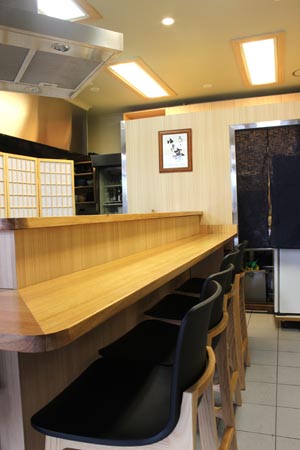
コースの最初は、しっかり出汁がきいていてホッとする味わいの、ほうれん草とえのきのおひたし。仕入れや季節によって内容が変わるこの小鉢。「まだまだ暑いでしょ、この時期はサッパリしたものの方がいいと思うから、おひたしや白和えだね」と津崎さん。こういった細やかな気遣いがうれしい。
続いては、サーモンとハマチの刺身。コースの刺身だと薄切りで物足りないこともあるが、ここのは厚めに切られていて刺身を食べたという満足感が得られるのが良い。こちらも仕入れによって内容が変わることがあるとか。
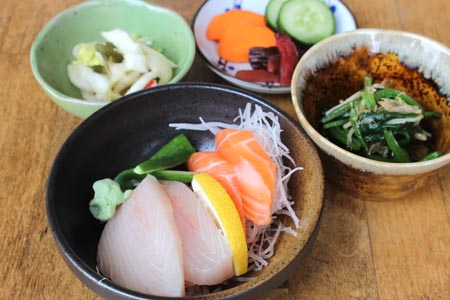
メインの天ぷらは、揚げる前に食材をお披露目。新鮮な海老や鱚(キス)などのシーフードや季節の野菜が並び、期待が高まる。そして、カウンターに目をやると大量の大根おろしが。「大根おろしは薬味としてではなく、天ぷらのお供として一緒に食べる感じで天つゆにたくさん入れて下さい」と津崎さん。更に「ウチは、塩とカレー粉で食べるの。変わってるでしょ?」と。確かに塩と抹茶はよく聞くが、カレー粉は珍しい。2本ある海老のうち1本はカレー塩でいただく。これがビックリする程合うのだ。塩が海老の旨みを引き出し、カレーの風味がそれを包み込む。こんな食べ方もあるんだと新しい発見。そしてもう1本は、天つゆで大根おろしをたっぷりのせていただく。こちらは天ぷら王道のおいしさ。その後、一品一品天ぷらが出てくるのだが、「これは、どちらで食べた方が良い?」なんて会話を楽しみながら食べ進む。味がグッと引き出された野菜も良いが、個人的には軽く煮てほんのり甘い穴子が気に入った。ちなみに、穴子は定番とのこと。
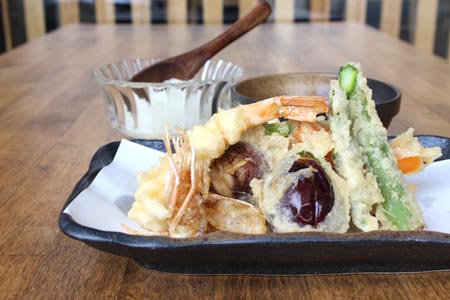
天ぷらの後は、天ぷら茶漬け、天丼、かき揚げの中から好みのものを選ぶ。メルボルンでは珍しい天ぷら茶漬けを注文。海老のかき揚げがのったご飯に昆布茶をかけていただくのだが、旨味のあるかき揚げと塩気のある昆布茶が絶妙な味わいで、サラサラとご飯がお腹に入っていく。
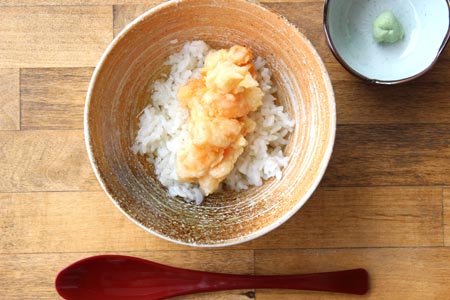
最後は、抹茶アイスの天ぷら。熱くて冷たい不思議な食感が魅力的だ。
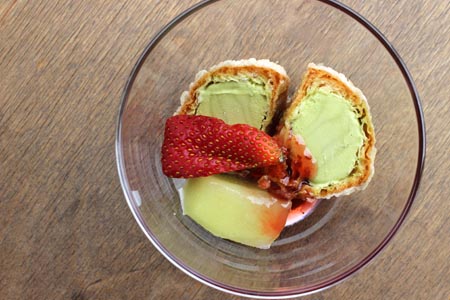
粉と油は日本から仕入れているこだわりの天ぷら。気心の知れた友人とおいしいものをという時に訪れたい店。空きがあれば予約なしでも入れるが、席数が少ないので予約した方が無難かも。ごちそうさまでした。
Serious Tempura In a Lighthearted Venue
Tempura is among the most famous Japanese dishes. These days, it tends to have a high-class image, but back in the Edo period, it was, along with sushi and soba, considered one of the 'three flavours of Edo' - commoner food, sold from stalls. This month, we visited Yuki Tei, a tempura specialist that offers takeout for lunch, and a set course ($55) for dinner. That course, which includes eight types of tempura, is the only item on the dinner menu, by the way (BYO alcohol is available for a $5 corkage fee). "I spent many years doing takeaway, but I really wanted to make tempura," says owner-chef Tsuzaki-san with a smile. Having spent time training at a famous tempura restaurant in Japan, Tsuzaki-san's course menu here reflects that establishment's style.
First up came the spinach and enoki ohitashi. With its strong dashi flavour, it's a relaxing entree. This course changes depending on ingredient availability and seasonality, but with the heat at this time of year, Tsuzaki-san felt that something refreshing, like ohitashi or shira-ae would work best. This level of consideration is what helps make a meal great.
Next, we tried the salmon and hamachi (yellowtail) sashimi. When served as part of a set menu, sashimi can sometimes be thinly sliced and insubstantial, but here, the flesh was thick and satisfying. This course, like the entree, can change in composition depending on market availability, though.
Before frying the ingredients for the tempura main, Tsuzaki-san introduces each to you. With the fresh seafood, including prawn and kisu (whiting), plus seasonal vegetables lined up in front of us, our excitement grew. Casting our eyes over the counter, we also saw a large pile of daikon oroshi. "Don't treat daikon oroshi as a condiment - treat it as a companion to the tempura and therefore add lots to the tentsuyu sauce," says Tsuzaki-san. He adds, "I eat tempura by dipping it in a mix of salt and curry powder. Unusual, right?". Unusual indeed. Salt and matcha is a common alternative to tentsuyu, but salt and curry powder? Given there are two prawns, I try one with this unique mix. It works shockingly well. The salt draws out the prawn's umami, which the curry flavour then envelops. It may not be the traditional method of eating tempura, but it certainly opened our eyes. We enjoyed the remaining prawn with the tentsuyu (complete with lots of daikon oroshi). This brought out the traditional deliciousness one associates with good tempura. After this, the various tempura continued to arrive, but as each came out, we now asked Tsuzaki-san which dipping he recommended, allowing us to enjoy some fun conversations while we ate. Of the remaining tempura, we enjoyed the expertly cooked flavours of the vegetables, but for us, the lightly simmered and faintly sweet anago (eel) was the personal favourite. It's wroth noting anago is also a standard (i.e. unchanging) menu item.
Following the tempura, you're offered a choice of tempura chazuke, ten don or kakiage. Given tempura chazuke's rarity in Melbourne, we went for that. Comprised of a prawn kakiage sitting on rice and kombucha poured over the top, the flavour balance between the umami of the kakiage and the saltiness of the komucha was just sublime, going down very easily indeed.
Rounding things off, we tried the matcha ice cream tempura. The combination of hot and cold was very appealing.
Yuki Tei imports both its batter flour and oil from Japan, such is its focus on quality. It's the perfect place to enjoy a delicious meal with close friends. If there are spaces available, you can eat without a booking, but given the small number of seats, it's safer to book. Gotchisousamadeshita.
Tempura Yuki tei
11/1A Grange Rd. Toorak
03 9826 3271
Takeaway Tue - Sat: 11:30am - 2pm
Dinner Tue - Sat: 6 - 10pm

